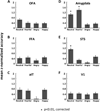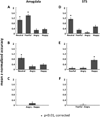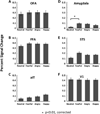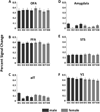Face-selective regions differ in their ability to classify facial expressions
- PMID: 26826513
- PMCID: PMC4808360
- DOI: 10.1016/j.neuroimage.2016.01.045
Face-selective regions differ in their ability to classify facial expressions
Abstract
Recognition of facial expressions is crucial for effective social interactions. Yet, the extent to which the various face-selective regions in the human brain classify different facial expressions remains unclear. We used functional magnetic resonance imaging (fMRI) and support vector machine pattern classification analysis to determine how well face-selective brain regions are able to decode different categories of facial expression. Subjects participated in a slow event-related fMRI experiment in which they were shown 32 face pictures, portraying four different expressions: neutral, fearful, angry, and happy and belonging to eight different identities. Our results showed that only the amygdala and the posterior superior temporal sulcus (STS) were able to accurately discriminate between these expressions, albeit in different ways: the amygdala discriminated fearful faces from non-fearful faces, whereas STS discriminated neutral from emotional (fearful, angry and happy) faces. In contrast to these findings on the classification of emotional expression, only the fusiform face area (FFA) and anterior inferior temporal cortex (aIT) could discriminate among the various facial identities. Further, the amygdala and STS were better than FFA and aIT at classifying expression, while FFA and aIT were better than the amygdala and STS at classifying identity. Taken together, our findings indicate that the decoding of facial emotion and facial identity occurs in different neural substrates: the amygdala and STS for the former and FFA and aIT for the latter.
Trial registration: ClinicalTrials.gov NCT01087281.
Keywords: Amygdala; Emotional faces; STS; SVM; fMRI.
Published by Elsevier Inc.
Figures








Similar articles
-
Dynamic stimuli demonstrate a categorical representation of facial expression in the amygdala.Neuropsychologia. 2014 Apr;56(100):47-52. doi: 10.1016/j.neuropsychologia.2014.01.005. Epub 2014 Jan 18. Neuropsychologia. 2014. PMID: 24447769 Free PMC article.
-
Investigating the brain basis of facial expression perception using multi-voxel pattern analysis.Cortex. 2015 Aug;69:131-40. doi: 10.1016/j.cortex.2015.05.003. Epub 2015 May 14. Cortex. 2015. PMID: 26046623
-
Lateralization for dynamic facial expressions in human superior temporal sulcus.Neuroimage. 2015 Feb 1;106:340-52. doi: 10.1016/j.neuroimage.2014.11.020. Epub 2014 Nov 15. Neuroimage. 2015. PMID: 25463458
-
Distributed and interactive brain mechanisms during emotion face perception: evidence from functional neuroimaging.Neuropsychologia. 2007 Jan 7;45(1):174-94. doi: 10.1016/j.neuropsychologia.2006.06.003. Epub 2006 Jul 18. Neuropsychologia. 2007. PMID: 16854439 Review.
-
Functional atlas of emotional faces processing: a voxel-based meta-analysis of 105 functional magnetic resonance imaging studies.J Psychiatry Neurosci. 2009 Nov;34(6):418-32. J Psychiatry Neurosci. 2009. PMID: 19949718 Free PMC article. Review.
Cited by
-
Association of P50 with social function, but not with cognition in patients with first-episode schizophrenia.Eur Arch Psychiatry Clin Neurosci. 2024 Sep;274(6):1375-1384. doi: 10.1007/s00406-023-01711-w. Epub 2023 Nov 15. Eur Arch Psychiatry Clin Neurosci. 2024. PMID: 37966511
-
The neural correlates of context driven changes in the emotional response: An fMRI study.PLoS One. 2022 Dec 30;17(12):e0279823. doi: 10.1371/journal.pone.0279823. eCollection 2022. PLoS One. 2022. PMID: 36584048 Free PMC article.
-
tDCS application over the STG improves the ability to recognize and appreciate elements involved in humor processing.Exp Brain Res. 2017 Jun;235(6):1843-1852. doi: 10.1007/s00221-017-4932-5. Epub 2017 Mar 15. Exp Brain Res. 2017. PMID: 28299412
-
Decoding six basic emotions from brain functional connectivity patterns.Sci China Life Sci. 2023 Apr;66(4):835-847. doi: 10.1007/s11427-022-2206-3. Epub 2022 Nov 11. Sci China Life Sci. 2023. PMID: 36378473
-
Equivalent processing of facial expression and identity by macaque visual system and task-optimized neural network.Neuroimage. 2023 Jun;273:120067. doi: 10.1016/j.neuroimage.2023.120067. Epub 2023 Mar 28. Neuroimage. 2023. PMID: 36997134 Free PMC article.
References
-
- Adolphs R, Tranel D, Damasio H, Damasio A. Impaired recognition of emotion in facial expressions following bilateral damage to the human amygdala. Nature. 1994;372:669–672. - PubMed
-
- Allison T, Puce A, McCarthy G. Social perception from visual cues: role of the STS region. Trends CognSci. 2000;4:267–278. - PubMed
-
- Andrews TJ, Ewbank MP. Distinct representations for facial identity and changeable aspects of faces in the human temporal lobe. NeuroImage. 2004;23:905–913. - PubMed
Publication types
MeSH terms
Associated data
Grants and funding
LinkOut - more resources
Full Text Sources
Other Literature Sources
Medical

